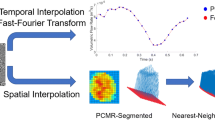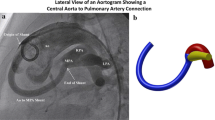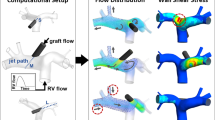Abstract
Long-term outcome following the Fontan operation may be affected by the amount of energy lost as blood flows through the anastomosis geometry. A method for detailed quantification of energy loss is applied to computational simulations of the flow in an atriopulmonary and a total cavopulmonary model. Five types of flow (near wall, slow recirculation, medium speed vortices, collision, and streamlined flow) are identified and their energy losses quantified. The presence of recirculation regions decreases the efficiency of the atriopulmonary model, and a region of increased energy loss is seen in the collision region in the total cavopulmonary model. However, the most significant energy loss is through wall shear stress, which is maximal in areas where there is rapid, near wall flow.






Similar content being viewed by others
References
de Leval MR, Dubini G, Migliavacca F, et al. (1996) Use of computational fluid dynamics in the design of surgical procedures: application to the study of competitive flows in cavopulmonary connections. J Thorac Cardiovasc Surg 111:502–513
Ensley AE, Lynch P, Chatzimavroudis GP, et al. (1999) Toward designing the optimal total cavopulmonary connection: an in vitro study. Ann Thorac Surg 68:1384–1390
Glagov S, Zarins C, Giddens DP, Ku DN (1988) Hemodynamics and atherosclerosis insights and perspectives gained from studies of human arteries. Arch Pathol Lab Med 112:1018–1031
Guadagni G, Bove EL, Migliavacca F, Dubini G (2001) Effects of pulmonary afterload on the hemodynamics after the hemi-Fontan procedure. Med Eng Phys 23:293–298
Healy TM, Lucas C, Yoganathan AP (2001) Noninvasive fluid dynamic power loss assessments for total cavopulmonary connections using the viscous dissipation function: a feasibility study. J Biomech Eng 123:317–324
Houlind K, Stenbog EV, Sorensen KE, et al. (1999) Pulmonary and caval flow dynamics after total cavopulomonary connection. Heart 81:67–72
Kim YH, Walker PG, Fontaine AA, et al. (1995) Hemodynamics of the Fontan connection an in-vitro study. J Biomech Eng 117:423–428
Ku DN (1997) Blood flow in arteries. Ann Rev Fluid Mech 29:339–434
Low HT, Chew YT, Lee CN (1993) Flow studies on atriopulmonary and cavopulmonary connections of the Fontan operations for congenital heart defects. J Biomed Eng 15:303–307
Moyle KR (2003) Haemodynamics of the Fontan connection; investigating patient specific model creation and validation from MRI data. PhD thesis, Mechanical Engineering, University of Auckland, Auckland New Zealand
Sciubba E (1997) Calculating entropy with CFD. Mech Eng 1997:86–88
Sharma SA, Goudy SA, Walker P, et al. (1996) In vitro flow experiments for determination of optimal geometry of total cavopulmonary connection for surgical repair of children with functional single ventricle. J Am Coll Cardiol 27:1264–1267
van Haesdonck JM, Mertens L, Sizaire R, et al. (1995) Comparison by computerized numeric modeling of energy losses in different Fontan connection. Circulation 92:II-322–II-326
Were CJ (1997) The Free-ALE method for unsteady incompressible flow in deforming geometries. PhD thesis, Mechanical Engineering, University of Auckland, Auckland, New Zealand
Acknowledgments
Financial support was provided from the National Heart Foundation of New Zealand and the University of Auckland.
Author information
Authors and Affiliations
Corresponding author
Rights and permissions
About this article
Cite this article
Moyle, K., Mallinson, G., Occleshaw, C. et al. Wall Shear Stress is the Primary Mechanism of Energy Loss in the Fontan Connection. Pediatr Cardiol 27, 309–315 (2006). https://doi.org/10.1007/s00246-005-0918-3
Published:
Issue Date:
DOI: https://doi.org/10.1007/s00246-005-0918-3




